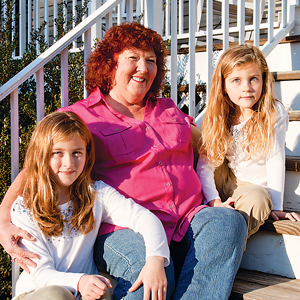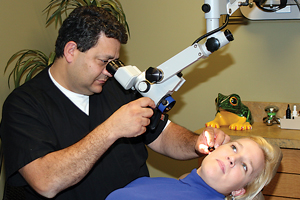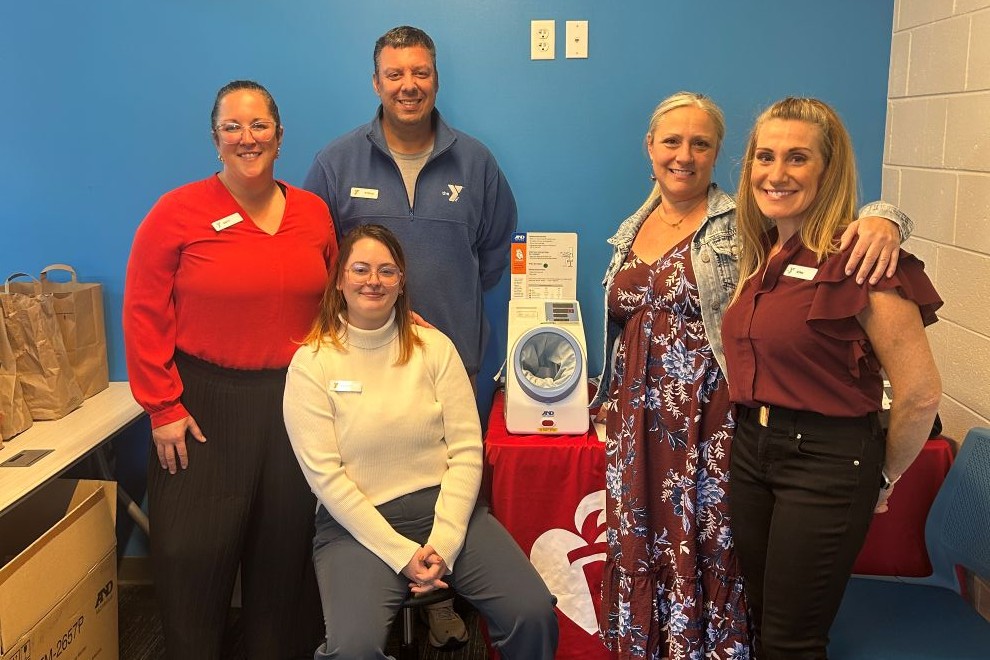 Charlotte Steele put in a call to a repairman recently when she heard an odd clicking sound coming from her electric stove. She had purchased the stove three years ago and had never heard that noise before. When the repairman came out, he told her the noise was completely normal; it happened every time the stove was warming up. Steele, 62, laughs as she recalls the incident. For most of her life, she has lived with conductive hearing loss. In October of last year, she received a bone-anchored hearing device that crystallized her hearing. “I’m hearing better now than I have ever heard,” she says.
Charlotte Steele put in a call to a repairman recently when she heard an odd clicking sound coming from her electric stove. She had purchased the stove three years ago and had never heard that noise before. When the repairman came out, he told her the noise was completely normal; it happened every time the stove was warming up. Steele, 62, laughs as she recalls the incident. For most of her life, she has lived with conductive hearing loss. In October of last year, she received a bone-anchored hearing device that crystallized her hearing. “I’m hearing better now than I have ever heard,” she says.
Steele, a retired office worker, lives and works on a farm with her husband in Prince Edward County. This mother of three and grandmother of two has had trouble with her ears ever since she was a youngster growing up in Amelia. “As long as I can remember,” she says, noting that she suffered with agonizing earaches that played havoc with her hearing. “It would be so bad that I would have to sit right next to the teacher to hear.”
Her mother would take her to the doctor for a shot of penicillin or ear drops and she would be okay until the next ear infection. “It got worse as I got older,” she says. “When I was seventeen, my older brother brought me into Richmond for my first ear operation.”
Steele says she was adamant about getting her own kids to the pediatrician if ear-trouble seemed likely. She advised her son and his wife, who live in Powhatan, to do the same. “If my granddaughters were tugging at their ears, I was the first one to say, ‘Get them looked at!’” Steele says.
Later, Steele was a patient of Fred Shaia, MD, who performed several mastoid operations to remove infection from the bone behind the ear. “I had one ear infection where I was in the hospital for 21 days,” says Steele, who was in her thirties at the time. “They had to open the mastoid and scrape the bone. Each time I had an infection my hearing got worse.”
For a while, Steele wore hearing aids but that could have been a dangerous proposition for her. “If you get a germ off the hearing aid, you can get an infection,” she says, adding that she also couldn’t get any water or moisture in her ears.
Fortunately, Steele never had any nerve damage from the infections. But what about the quality of her hearing? Well, if someone stood near her and spoke loud enough, she could hear them. “If you were in the other room, I couldn’t understand you,” she says. “I needed to see people’s faces and watch their lips.”
A few years ago, Steele began seeing the son of Dr. Fred Shaia, Wayne Shaia, MD. Like his father, he’s an otologist and neurotologist at the Balance & Ear Center in Richmond, one of Virginia’s leading practices in developing and advancing techniques in hearing. When the younger Shaia mentioned a different approach to improving her hearing, the bone-anchored hearing system, Steele had some concerns about the procedure. When her ear problems continued to worsen, however, she reconsidered. “I built up trust in Dr. Wayne Shaia,” she says. “He is a great doctor, and he told me I was a great candidate for the procedure.”
Steele’s worries were alleviated when she realized the implanted device wasn’t uncomfortable at all. “It didn’t even feel like I had anything foreign in my skull,” she says. “People think you are putting something in your skull, but I had a knee replacement so I thought if that worked, I need not worry about my head.”
Steele added that unlike many hearing aids, the device isn’t visible. “Nobody knows I have it because it’s hidden in my hair.”
The bone-anchored hearing system known as Baha uses bone conduction to carry sound to the inner ear and the auditory nerve. “It’s different from a typical hearing aid that is placed on the ear externally and has a microphone that goes into the ear which picks up the sound and amplifies it,” Dr. Shaia says.
A leader in hearing technology, Dr. Shaia plans to perform the procedure to implant the hearing system at MEDARVA at Stony Point Surgery Center. The titanium implantable hearing device, which vibrates the sound through the bone to the inner ear, is implanted into the mastoid bone. The abutment connects to a cone-shaped processor that clips onto the hearing device.
 Over the years, Dr. Shaia has helped develop more efficient ways to reduce surgery time and costs. The surgical procedure for implanting the abutment takes less than a half-hour. “Then you have to wait a month before you can fit the patient with the oscillator to allow the bone to heal,” Dr. Shaia says. “We do about 20 of these procedures a year.” He says the difference between a typical hearing aid and this system are measurable and immediate.
Over the years, Dr. Shaia has helped develop more efficient ways to reduce surgery time and costs. The surgical procedure for implanting the abutment takes less than a half-hour. “Then you have to wait a month before you can fit the patient with the oscillator to allow the bone to heal,” Dr. Shaia says. “We do about 20 of these procedures a year.” He says the difference between a typical hearing aid and this system are measurable and immediate.
“When sound comes through a hearing aid there is resistance,” Dr. Shaia says. “When sound travels through the skull there is no resistance. The sound is directed toward the hearing nerve which allows patients to hear.”
Today, manufacturers often ask him to share his techniques and procedures with other healthcare professionals.
According to Dr. Shaia, the procedure is used for people with single-sided deafness as well as people who have congenital hearing loss or chronic ear infections, like Steele. The drainage in the ear canal or middle ear from the infection makes it difficult for people with this chronic condition to use a traditional hearing aid. The bone-anchored hearing device sends sound directly to the inner ear without having to use the ear canal and middle ear.
In order to have the life-changing procedure, “at least one hearing nerve in the ear has to work,” says Dr. Shaia.
The bone-anchored device, which has been used in Europe since 1977, was given FDA approval for use in conductive and mixed hearing losses in 1996 and for one-sided deafness in 2002. It is covered by Medicare and Medicaid, as well as other commercial insurance companies.
The device gives patients two-sided hearing. “It helps their hearing become more normal,” Dr. Shaia says, adding that the day the device is turned on can be a magical one for patients. “Some people that haven’t heard for years get quite emotional. They can hear speech at a normal tone.”
Steele remembers the day the device was turned on. She was so overwhelmed she almost cried. “It was like – wow!” she says. “What I could hear was so crisp and clear and loud. It was just amazing!”
Now every time she hears a noise like that stove clicking, she wonders if it’s a new noise or something she just couldn’t hear over the years. She often asks family and friends, Is that the way it’s supposed to sound?
“I wish I had had this device when I was working,” says Steele, who was employed as a statistical assistant, but is now retired from that field and working on the farm. “I’m glad that I did it.
Thank goodness I said ‘yes’ to this.” The father and son medical team of Fred Shaia and Wayne Shaia, who still collaborate at the Balance and Ear Center, are glad she said yes, too. “Helping patients like Charlotte Steele achieve better hearing, and in some cases having the opportunity to give hearing back to patients, gives us absolute joy,” says Dr. Wayne Shaia.




